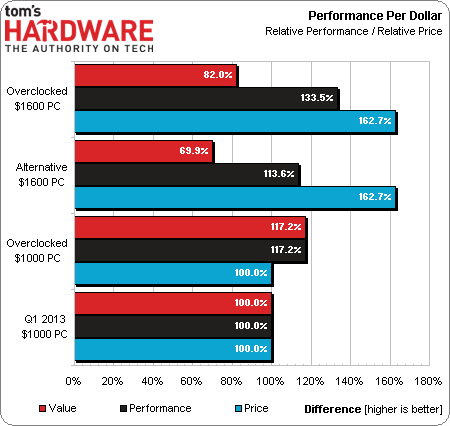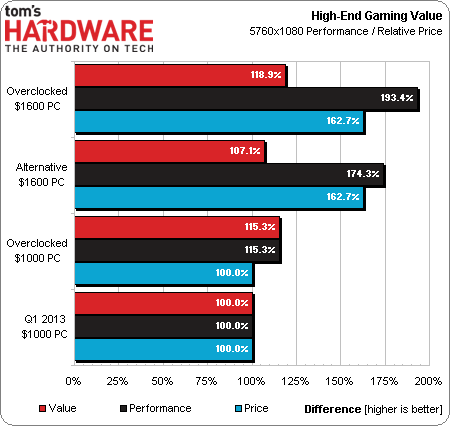System Builder Marathon, Q1 2013: $1,600 Alternative PC
The Less-Obvious Benefits Of Spending More
Today’s $1,600 build started out as an upgrade to my original $1,000 Performance PC, and should have contained only the components needed to make that build perform better. At the end of the day, however, I had to spend a little more on a motherboard that didn't help my performance, but rather addressed a couple of show-stopping flaws. Those issues were revealed when I paired an E1-stepping CPU with 1.65 V RAM, and then added a very heavy cooler with a very high-tension mounting kit.
Because I had problems with both the CPU memory controller and motherboard flex, I can’t be completely sure that Noctua's NH-D14 isn’t responsible for the whole mess. I only know from experience that the big cooler had a negative impact on at least three of my ASRock Z77 Extreme4 motherboards. And I’m not willing to talk about what might have happened to my fourth motherboard sample in my mad rush to find the problem.
I also know that Intel explicitly states that 1.50 V plus or minus 5% is the limit for Ivy Bridge-based processors, while at the same time validating the use of 1.65 V memory. I further know that the Z77 Extreme4 automatically sets 1.665 V for DDR3-2133, that ASRock’s set voltage levels are slightly lower than its actual voltage levels, and that nobody has given me proof of the E1-stepping Core i5’s ability to cope with voltage levels approaching 1.7 V.
In the end, I was forced to either give up the big CPU cooler or try a different motherboard model. In the end, I was forced to scale back to low-voltage RAM. And, in the end, I was left with ten days, two processors, and four motherboards wasted.
All of that work, and I still don’t see any increase in overall value when it comes to the performance-per-dollar charts. I do like that the system is quieter, that its case is more durable, that its power supply has more connectors, and that the extra hard drive provides room for all my old media files.
I also like that it can game at 5760x1080. You see, the $1,000 PC, for all of its performance and overall value hype, simply couldn’t be called a consistent triple-display performer. Most games needed a second GPU to produce smooth 5760x1080 frame rates, and some game settings even required the second card simply to reach 2560x1600.
The only thing that could make the $1,000 PC a universal gaming box is if we limited it to 1920x1080. Real quality-seekers will find real gaming quality in the $1,600 build, which also has a better case, motherboard, CPU cooler, and more storage capacity. Even though we paid money to get those non-gaming improvements, the second card still pushes this system’s gaming value far beyond that of our original $1,000 build.
Current page: The Less-Obvious Benefits Of Spending More
Prev Page Power, Heat, And EfficiencyGet Tom's Hardware's best news and in-depth reviews, straight to your inbox.
-
Crashman Azn CrackerAren't the 7870 myst only $240 a piece?See This?Reply
Article TextThe prices in that table were what we paid when the parts were ordered, and a lot of them changed over the last six weeks. For example, the PowerColor card is $20 less, per board. Other prices are up. All told, then, the total cost of buying our machine and replicating the build is within $20 of our original invoice. -
mikenygmail Please call the graphics cards 7870 LE from the start, like this:Reply
"Video Cards: 2 x 7870 LE - PowerColor PCS+ AX7870 Myst Edition"
After all, it is much more than a standard 7870.
I had no idea it was the LE until I got to the third page. -
Crashman mikenygmailPlease call the graphics cards 7870 LE from the start, like this:"Video Cards: 2 x 7870 LE - PowerColor PCS+ AX7870 Myst Edition"After all, it is much more than a standard 7870.I had no idea it was the LE until I got to the third page.In AMD/ATI model lingo, LE stands for a cut-down part. So a Tahiti-LE wouldn't be a 7870 LE, it would be a 7950 LE. The fact that it carries the 7870 model number is unfortunate, but the article attempts to make it clear that this is indeed a Tahiti-LEReply
-
Crashman StickmansamWhy not the 7870XT like Sapphire calls it?That's fine, please tell AMD to do the re-brand!Reply -
pyro226 "a board damaged a processor that in turn damaged every board it touched, which in turn would damage every processor it touched" and ram damaging a CPU?Reply
I think I'm a bit afraid to build computers now. If either of those situations would have happened to my $600 build, I would have cried and given up... -
Fulgurant pyro226"a board damaged a processor that in turn damaged every board it touched, which in turn would damage every processor it touched" and ram damaging a CPU?I think I'm a bit afraid to build computers now. If either of those situations would have happened to my $600 build, I would have cried and given up...Reply
That sort of thing happens once in a blue moon. Don't let it bother you.
I guess Tom's tale of woe summarizes why Intel recommends against higher than 1.575 volts on the memory controller of Ivy/Sandy:
http://www.intel.com/support/processors/sb/CS-029913.htm#4
IntelWhat are the Intel® Core™ i7 desktop processor DDR3 memory voltage limitations?Intel® recommends using memory that adheres to the Jedec memory specification for DDR3 memory which is 1.5 volts, plus or minus 5%. Anything more than this voltage can damage the processor or significantly reduce the processor life span.
In any case, the performance benefits of overclocking memory on a Sandy/Ivy platform seem so miniscule that it's scarcely even worth considering. Buy memory capable of an appropriate speed @ 1.5V, and leave it be.
(I know Tom mentions Intel's position on memory voltage on the last page of the article, but I wanted to re-emphasize it because I've seen literally hundreds of people dismiss Intel's statement on various hardware forums. When sites like Tom's Hardware push limits, even for questionable performance gains, we all benefit -- but when someone who's on a budget and might not know any better pushes limits on his own, hard-earned hardware, the results might be tragic. Tom's experiments with this stuff so we don't have to.) -
Crashman pyro226"a board damaged a processor that in turn damaged every board it touched, which in turn would damage every processor it touched" and ram damaging a CPU?I think I'm a bit afraid to build computers now. If either of those situations would have happened to my $600 build, I would have cried and given up...I told Chris the system was cursed, but he refused to let the project go after the seventh day. Three more days rescued the content, if not the hardware...Reply
FulgurantThat sort of thing happens once in a blue moon. Don't let it bother you.Once every 12 years is twice in 13 years too often...



